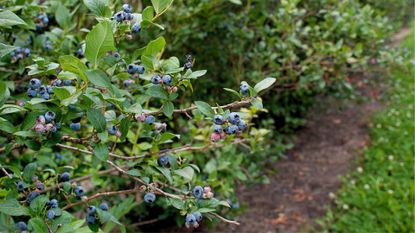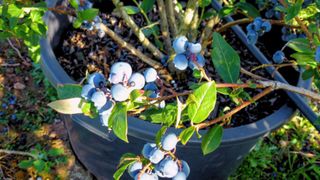Top 10 Questions About Blueberries


Here at Gardening Know How we get lots of questions, and our goal is to provide answers to those inquiries to the best of our knowledge. Of these questions include blueberry plants. Here are some of the most popular questions about blueberry bushes people have when rowing them in the landscape.
1. How and when to prune blueberry plants?
Prune blueberries every year in late winter or early spring when the branches have buds, but after danger of hard freeze has passed. Begin by removing all dead and damaged growth, plus canes that cross or rub against other canes. Prune canes that may inhibit air circulation in the middle of the bush, then remove the two oldest canes every year. If you aren't sure which canes to remove annually, prune those that have no buds and/or unproductive canes that haven't produced growth in past seasons.
2. What fertilizer is needed for blueberry shrubs?
If possible, have your soil tested every few years to determine the pH level, as optimum pH for blueberries is 4.5 to 5.0. If the pH level is too high, you may need to adjust it by incorporating sulfur or certain organic materials. Fertilize your bushes with a product formulated for blueberries, azaleas, rhododendrons or other acid-loving plants, or use a well-balanced fertilizer with a ratio such as 10-5-5 when growth begins in early spring and again after harvest. Spread the fertilizer evenly around the plant, and then water in well.
3. No flowers? / Do blueberries have a resting year?
If your blueberries have always bloomed in the past, make sure a nearby tree hasn't grown to the point that it shades the blueberry bush. Although a few hours of light shade is okay, blueberries won't bloom without several hours of direct sunlight. Prune blueberry bushes in late winter or early spring and keep in mind that later pruning may remove tiny buds. Remove older canes every year, as three- to six-year-old canes tend to be most productive while older canes get weaker and less productive with age. Be sure to fertilize and water regularly.
4. How to get sweeter blueberries?
Sour blueberries is a common complaint. Weather may be a factor, as blueberries tend to be sweeter in dry years. Experts at a local nursery can tell you which blueberries are best for your climate. Ask for sweet blueberries, as some varieties are naturally tart. Be careful about purchasing bushes at big box stores because plants are often shipped long distances and may not be ideal for local growing conditions. Perform a soil test to ensure your soil pH is between 4.5 and 5.0, then take steps to adjust, if necessary. Lastly, be sure the berries are fully ripe before picking.
5. Can I transplant my blueberry plants and, if so, when?
Transplant blueberries during the dormant season, typically between November and March in most climates. Transplanting in cool weather provides time for the roots to establish before the arrival of warm weather, but never transplant a blueberry plant during a hard freeze. If you live in a climate with very harsh winters, transplanting in spring is safer for the bush. Mulch the plant well after transplanting, but leave a span around the plant and don't allow mulch to mound against the stem.
6. Why don't my blueberry plants produce berries?
There are a number of possible reasons why blueberries aren't producing, but improper soil pH is at the top of the list. Blueberries require acidic soil with a pH of 5.5 or lower. Test your soil and amend with aluminum sulfate or elemental sulfur if the pH is too high. There's also a possibility your bushes aren't being pollinated. Although most types are self-fruitful, it helps to have another bush within about 100 feet. Be sure the plants get several hours of full sunlight and that the soil drains well as blueberries don't like wet feet.
Gardening tips, videos, info and more delivered right to your inbox!
Sign up for the Gardening Know How newsletter today and receive a free download of our most popular eBook "How to Grow Delicious Tomatoes."
7. Can I grow blueberries in a container?
Blueberries, especially dwarf varieties, are well suited for containers. Although you can plant in a container with an 18-inch (45 cm.) diameter, you'll eventually need to move the bush to something larger, like a whiskey barrel. Fill the container with a potting mix such as half peat moss and half bark to provide the proper acidic pH level, and never use garden soil in containers. Be sure to water frequently, as soil in containers dries quickly. Bury the container in the ground in mid-autumn, then add a generous layer of mulch, or move the blueberry bush into an unheated garage.

8. What causes blueberries to shrivel or drop off?
Drought is frequently the cause when blueberries shrivel and drop off. Blueberries need consistent moisture, especially during the first couple of years. Provide about 1 inch (2.5 cm.) of water per week, increasing to 4 inches (10 cm.) when berries are ripening. If the berries look pinkish-gray and drop just before harvest, they may be infected with a fungal disease known as mummy berry. The most important thing is to clean up all dropped berries; otherwise, they overwinter and sprout tiny mushrooms capable of producing millions of spores that spread disease to neighboring plants. Mummy berry is difficult to manage, but fungicides may help.
9. Can you propagate blueberries from cuttings?
Blueberries are easy to propagate. Remove a 6-inch (15 cm.) stems from a healthy plant in summer, when stems are still flexible. Remove the leaves from the lower half of the stem, then plant it in a small pot filled with peat moss and coarse sand. Place the pot in a plastic bag and put it in indirect light. Water as needed to keep the potting mix moist, but open the bag for a couple of hours if you notice condensation. When roots appear, usually in two to three months, move the bush into a slightly larger container filled with acidic potting mixture. Place the container in light shade, then transplant into the garden in autumn.
10. How to care for blueberries in the winter?
Blueberries are tough plants once established and many will tolerate temperatures of -20 F. (-29 C). Never fertilize after July, as tender new growth is easily nipped by light frost. Water regularly throughout autumn; well hydrated plants are better able to tolerate cold. Spread 4 to 6 inches (10-15 cm.) of mulch around the plant after the first freeze to protect the plant from repeated freezing and thawing, but be sure to remove mulch in early spring. If the plant is new or you live in an extremely cold climate, you may want to cover the entire bush with burlap as part of your blueberry winter care.
We all have questions now and then, whether long-time gardeners or those just starting out. So if you have a gardening question, get a gardening answer. We're always here to help.

A Credentialed Garden Writer, Mary H. Dyer was with Gardening Know How in the very beginning, publishing articles as early as 2007.
-
 How To Get Rid Of Mosquitoes In The Garden: 9 Natural Ways To Make Them Buzz Off!
How To Get Rid Of Mosquitoes In The Garden: 9 Natural Ways To Make Them Buzz Off!How to get rid of mosquitoes is on the minds of people in the summer in almost every region of the world. Learn how to repel the pests without toxic chemicals.
By Mary Ellen Ellis
-
 Monkey Orchid Care: How To Grow This Fascinating Species
Monkey Orchid Care: How To Grow This Fascinating SpeciesThe monkey orchid (Dracula simia) bears a remarkable resemblance to its namesake and, with a little know-how, can be successfully grown as a houseplant.
By Bonnie L. Grant